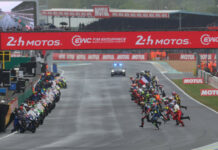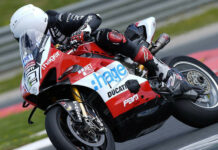Editorial Note: This article originally appeared in the March 2022 issue of Roadracing World & Motorcycle Technology magazine.
Kyle Wyman’s Harley-Davidson Road Glide 131R Bagger
When Hogs Fly
By Chris Ulrich
Racing Is Entertainment
A bagger and a racetrack are not two things that really seem to go together with a positive outcome. Or at least not until 2020, when MotoAmerica hosted the King Of The Baggers invitational exhibition race at WeatherTech Raceway Laguna Seca. Purists scoffed at the concept and MotoAmerica took a lot of heat, but they pulled it off, gaining a massive amount of exposure and more importantly, attracting a new audience to the sport of road racing. Even Superbike mechanics came out to the pit wall to watch the race, and none of the bikes oiled the track.
That wildly successful first event led to King Of The Baggers (KOTB) races being included in three rounds during the 2021 MotoAmerica season, and all three of those races were aired on FOX Sports TV. The rival Bagger Racing League held two events, and Baggers are starting to gain traction at the club level, too, with forward thinking club racing organizations, like the California Racing Association (CRA), adding a class for baggers, giving riders an opportunity to test and race outside of the major sanctioned events.
My first on-track experience with a bagger wasn’t riding, but following, when I was asked by MotoAmerica to shoot some onboard footage at Laguna Seca (from my Suzuki GSX-R1000R 2-Seat Superbike) following Ben Bostrom on a Feuling Parts Harley-Davidson Road Glide. Bostrom was on the gas from pit out, despite the Big Twin bucking and wobbling all over the racetrack. He was faster than I expected and it was impressive to watch. Big movement while pushing the limits at speed on the racetrack is part of the game when you take a bike that was originally designed to cruise down the highway or meander through the canyons. That’s right, meander.

While Harley-Davidson didn’t have an official team in the exhibition races, the brand obviously saw value in going racing and established a link between new model development, the Screamin’ Eagle Performance department, and racing in the KOTB series, which allowed the group to justify going racing. But there was a caveat for 2021: All members of the racing team had to continue to do their day jobs at Harley-Davidson, meaning anyone participating the KOTB program would be volunteering on their own time. Like most racing projects, it was part marketing, part engineering, and all fueled by passion.
Helping justify the racing program was the fact that there has been a shift in the market, with more riders wanting a more functional street motorcycle combining higher performance with the traditional bagger look and feel. Going racing allows Harley-Davidson’s Screamin’ Eagle Performance parts and accessory department to develop parts in racing and use the on-track success to reinforce the motor company’s high-performance credentials in the bagger arena. To Harley-Davidson’s credit, new 2022 models carry styling cues and upgrades from the 2021 KOTB racebikes. Win on Sunday, sell on Monday still works when applied correctly.

Zero To Racing In Four Months
Harley-Davidson’s new official KOTB program kicked off in January 2021, with the first race scheduled at Road Atlanta in April. A ton of work had to be done to get the bikes on track in such a short amount of time. The group chose Superbike race team owner/rider Kyle Wyman as the lead rider for the project with his brother, Travis, filling a second spot on the team starting at the second round.
In 2021, Kyle won the KOTB Championship, taking wins at Road America and Laguna Seca. Travis finished fifth overall with a best finish of third. It’s clear Harley-Davidson showed up to win.
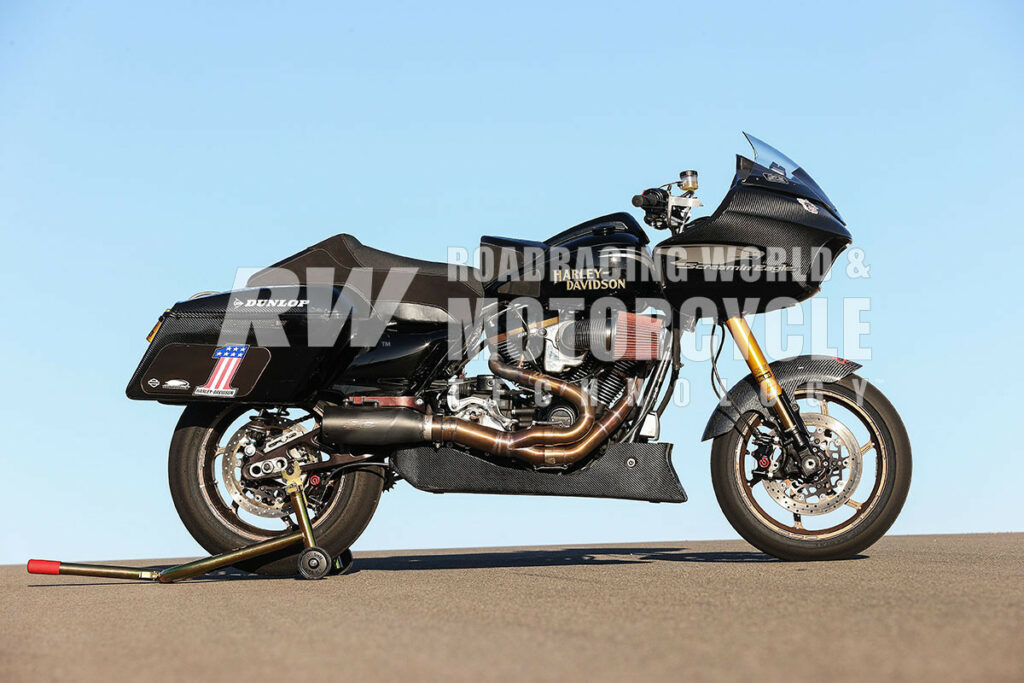
Top Secret Tech Details
Wyman’s 2021 Championship-winning Harley-Davidson Road Glide 131R is heavily modified for KOTB racing. Given the rivalry between Indian and Harley-Davidson, engineers were reluctant to give away very many details of their winning weapon.
Everything is big on this bagger racebike from the massive air-cooled engine to the 65-inch wheelbase and 631-pound race weight. The dimensions of the motorcycle are extreme.
Electronics are limited, so the baggers must run the stock ECU and are not allowed to use data acquisition during race events. For testing, Harley-Davidson engineers run data through an AIM MXS 1.2 data logger dash. That means most of the performance modifications are old school, i.e. mechanical. But just looking at the parts used and engineering time required, I’d estimate the build cost for a top-line bagger to be between $150,000 and $200,000 without including the cost of the stock bike.

At the heart of the Road Glide is an air-cooled 45-degree V-Twin Milwaukee-Eight 131R engine. HD engineers used an upgraded version of the Screamin’ Eagle 131 cubic inch (2,151cc) crate engine offered as an aftermarket replacement engine for the road. Upgraded camshafts are used and the shape of the piston dome has been changed to increase compression, and higher flow injectors are added to improve performance. The end result is an engine that Harley-Davidson claims puts out around 150 bhp and over 150 lbs.-ft. of torque at the rear wheel. Heat dissipation is the limiting factor for the Milwaukee-Eight engine, so engineers added larger fins to the cylinder heads and put the horn housing back onto the bike to push more air to the rear cylinder. A large oil cooler is fitted in the opening in the carbon-fiber front fairing; engineers pay close attention to the oil temperature to balance heat dissipation without having to increase oil viscosity, which reduces power output. On the racetrack the engine averages 6,000 rpm with redline set between 6,600 and 6,800 rpm, well above the stock rev limit.
On the chassis side, the big challenge is to create enough cornering clearance and still get the bike to go around the racetrack. There are some challenges to converting a bagger that comes with floor boards into a racetrack-capable machine with footpegs. There is no way to mount rearsets on the frame, so the billet primary drive and transmission covers are machined with peg mounts. The peg to ground height is 18.8 inches (480 mm) and the seat height is 36.6 inches (930mm), which is roughly four inches higher than an average sportbike. The peg-to-seat distance is 17.7 inches (450mm), which is a bit cramped for me. For better race ergonomics, the set-back stock handlebars have been replaced by a one-piece motocross/flatrack style bar. A large pommel was also added to the rear of the fuel tank so the riders can actually hang off, and the unit used on the bike I rode was version 4.0.
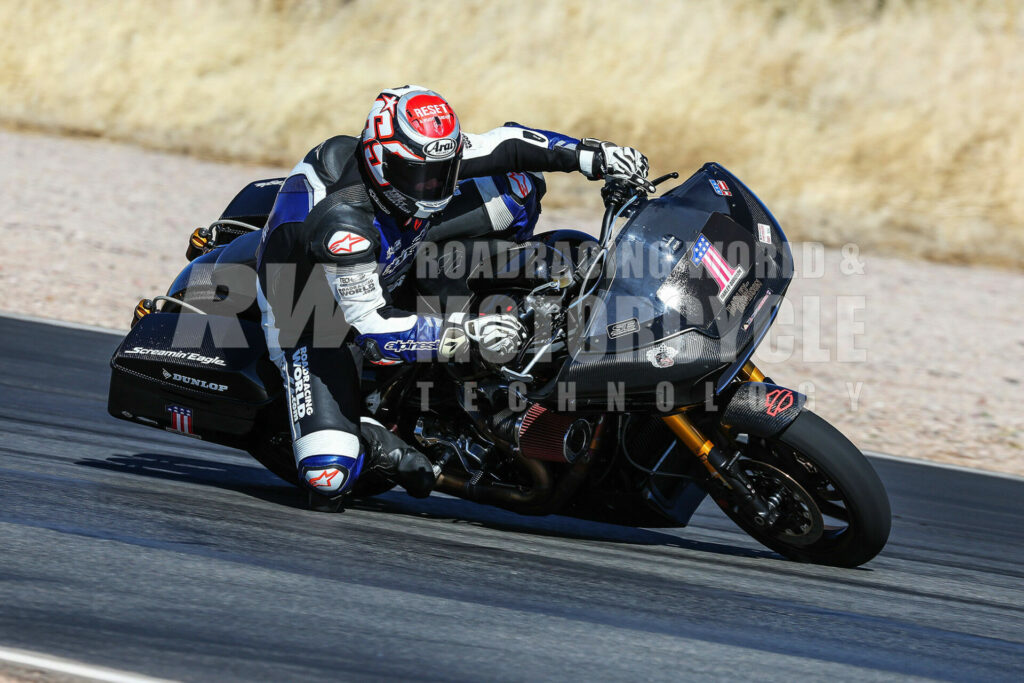
The KOTB race spec Road Glide must use the stock mild-steel, backbone-style frame, but the rest of the chassis is wide open. The rake is stock, sitting around 25.5 degrees, but the trail is around 160mm, which is close to the stock trail on the stock Road Glide, but very extreme compared to a sportbike. The stock triple clamps were replaced with custom made, fully adjustable units. Like the stock bike, the fork mounts on the triple clamps are also offset (pushed out forward) from the steering stem, which increases the wheelbase and trail numbers. The conventional forks have been replaced by inverted 43mm Öhlins FGR 250 racing front forks. At the rear there is a set of Öhlins-built Screamin’ Eagle Shocks. The custom swingarm is machined from a 400-pound piece of billet aluminum down to the 18-pound unit used on the racebike. The swingarm mounts directly to the engine using rubber bushings, so there is a bit of movement when leaned over. Wheelbase on the bike tested was 65-inches (1651mm).
Stopping the Bagger is a set of radial-mount Accossato racing mono-bloc calipers with 34mm titanium pistons combined with a Brembo RCS master cylinder. The big bagger uses a set of 300mm front brake rotors, which is on the small side for such a heavy bike. Harley-Davison plans to upgrade the brake system to use Brembo mono-bloc calipers combined with a set of 330mm front rotors.
At the rear, Harley-Davidson engineers used another 34mm piston radial-mount front caliper with a 300mm single disc. Wyman, a former dirt tracker, relies on the rear brake to get the Bagger to rotate around the middle of the corner. The Road Glide rolls around on 17-inch Core Moto Apex 6 forged aluminum wheels.
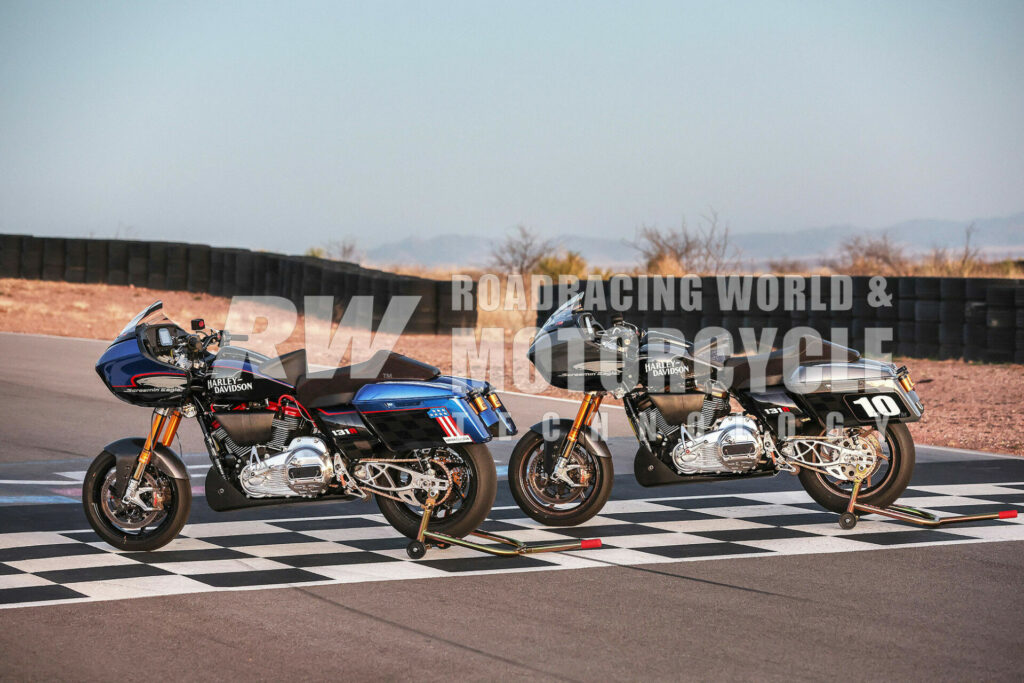
A Bagger On Track
I hate to admit it, but for the first time in a long time, I was nervous and maybe a little intimidated to ride a motorcycle. I think the last time I’d had anxiety (besides normal pre-race jitters) about riding a motorcycle on a racetrack was at Brno Circuit in 2004, but that was on a MotoGP bike on course with all the MotoGP riders.
I was at Inde Motorsports Ranch in the Arizona’s high desert about to throw a leg over a 631-pound bagger. I don’t know why, but the bike just looks intimidating. Maybe it was fear of the unknown. It may have also been because due to scheduling conflicts, I hadn’t been on a bike in a few months.

But my nerves calmed as I got suited up and threw my leg over the top of the Road Glide KOTB special. I could feel the weight of the bike as the crew let it down off the stand, stabilizing it with both feet. The 36-inch seat height combined with the big cylinders mounted high in the frame makes the bike a little unwieldly until you get used to it. Wobbling slightly, I clicked it into gear, opened the throttle while slipping the clutch and rolled out for my first laps behind 2021 KOTB Champion Kyle Wyman.
That unwieldy feeling carried onto the track, but corner-by-corner, I started to understand what I needed to do to ride the Road Glide. With a 65-inch wheel base, there isn’t much pitch on the brakes so you don’t get the same sensations from the front tire on corner entry. The most difficult part comes at turn-in, as the extreme height of the bike and high center of gravity make it difficult to initiate turn-in, but then the bike falls into the corner quicker than expected with a ton of momentum heading to full lean. I struggled to get my knee on the ground so it was difficult to judge lean angle. At the apex the Road Glide was really stable and gave great feedback. I pushed the front over one of the sealer patches, but it has so much trail that front came back immediately. And, surprisingly, it still finished the corner well. There was traction on corner exit; I think the weight of the bike helps drive the rear tire into the pavement. The lack of pitch to the rear didn’t cause any problems.
The Milwaukee-Eight engine was torquey, but also delivered smooth, linear power through the rev range. I was a little surprised how soft the power was in the lower part of the rev range, from first touch to about 1/3rd throttle. Power picked up as the revs climbed into the rev limiter which looked like it was set around 6,500. The engine makes a ton of power and torque on paper, but the sensation of power and acceleration is diminished by the weight of the bike.

The transmission ratios are spread out, so the throw between gears can be problematic. I had to be very deliberate during upshifts and downshifts on the bike. I didn’t time a downshift right on the first lap and caught a neutral off the back straight. I made sure I gave the bike a proper two-stroke blip every time I downshifted after that moment.
By the end of the four-lap sessions, I started to gain some confidence on the bike and pick up the pace. By this time, I figured out the timing on turn-in; my inputs just had to be very smooth and deliberate. I definitely needed to roll the bike into the corner. I could get my knee down in most corners, which was reassuring. And, once I figured it out, the Road Glide generally felt like a normal motorcycle; it stopped, turned, and accelerated, but with a character unique to a custom bike doing something it wasn’t designed to do. Harley-Davidson’s Road Glide Bagger actually gets around the racetrack pretty quickly, which is impressive.
Specifications: 2020 Harley-Davidson Road Glide Special Racebike
Engine Configuration: 45-degree V-Twin
Engine Displacement: 131 cubic inches (2,152cc)
Engine Cooling: Air
Combustion Chamber Design: Screamin’ Eagle Stage IV Heads
Valves Per Cylinder: 4
Intake Valves Per Cylinder (Material): 2 (Stainless Steel)
Exhaust Valves Per Cylinder (Material): 2 (Inconel)
Bore x Stroke: 4.31-inches x 4.5-inches (109.474mm x 114.3mm)
Connecting Rod Length (center-to-center): 8.015 inches (203.6mm)
Connecting Rod Material: Steel
Claimed Peak Rear-Wheel Horsepower: 150 bhp
Claimed Peak Rear-Wheel Torque: 150 lbs.-ft.
Engine Redline: 6,800 rpm
Valvetrain Type: Pushrod
Valve Adjustment Interval: Self-adjusting Hydraulic Lifters
Intake Valve Diameter: 41mm
Exhaust Valve Diameter: 34mm
Fuel Delivery System: Digital Fuel Injection
Throttle Body Venturi Size: 64mm
Air Filter Type: K&N Oiled Pleated Fabric Element
Exhaust System Type (Material): 2-1 (Stainless Steel)
Ignition System: Digital (Stock)
Lubrication System: Dry Sump, Screamin’ Eagle Pro High-Volume Oil Pump
Oil Capacity: 4-quarts Engine, 1-quart Transmission, 1-quart Primary
Engine Oil: Screamin’ Eagle SYN3 Full Synthetic 20w50 Motorcycle Oil
Fuel Capacity: 20 liters (5.3 gallons)
Transmission Type: 6-speed, Constant Mesh
Clutch Type: Multi-plate, Wet, Screamin’ Eagle High Capacity
Clutch Actuation System: Cable
Clutch Spring Type: Coil
Number Of Clutch Springs: 3
Number Of Clutch Plates: 10
Drive Plates: 10
Driven Plates: 10
Primary Drive: Link-Plate Chain
Primary Drive Gear Teeth: 24-26
Final Drive Sprocket Teeth: 47-53
Frame Design (Material): Stock FL Backbone (Steel)
Rake/Trail: 25.5 degrees/160mm
Measured Wheelbase: 65 inches (1,651mm)
Swingarm Type: Asymmetric Billet Aluminum Alloy
Seat Height: 36.6 inches (930mm)
Footpeg Height: 18.8 inches (480mm)
Footpeg to Seat: 17.7 inches (450mm)
Front Forks: Inverted Öhlins FGR250 Racing
Fork Tube Diameter: 43mm
Fork Adjustments:
Rebound Damping: 30-Click Range
Compression Damping: 30-Click Range
Spring Preload: 18-Turn Range
Front Wheel Travel: 130mm
Rear Wheel Travel: 81.5mm
Rear Suspension Type: Remote Reservoir Screamin’ Eagle by Öhlins 36mm Dual Shocks
Rear Shock Adjustments:
Rebound Damping: 36-Click Range
Compression Damping: 22-Click Range
Spring Preload: 25mm Range
Front Brakes: 300mm (11.8-inch) Dual Discs, Radial-mount 4-piston Accossato PZ001 Calipers
Rear Brake: 300mm (11.8-inch) Disc, 4-piston Brembo Caliper
Front Wheel: Core Moto Apex-6 17-inch x 3.50-inch Forged Aluminum Alloy
Rear Wheel: Core Moto Apex-6 17-inch x 6.00-inch Forged Aluminum Alloy
Front Tire: 120/70-R17 Dunlop KR448
Rear Tire: 200/60-R17 Dunlop KR451
Claimed Racing Weight: 631 pounds
Weight Distribution, Percent: (46F/54R)
Estimated Build Cost: $150,000 – $200,000




